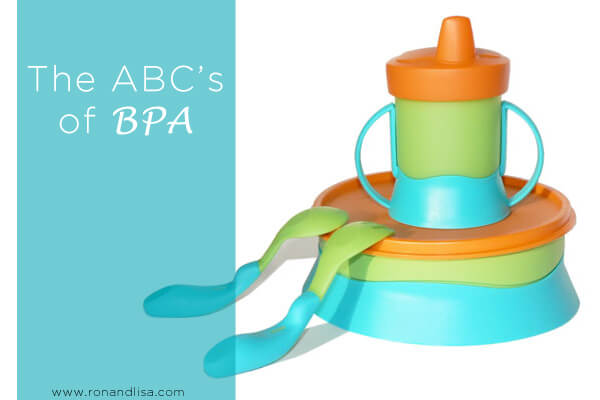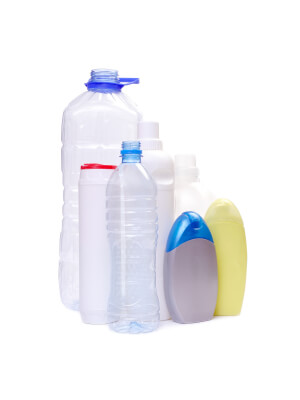BPA, PVC, PFC’s and PBDE’s. Nowadays, you almost need a minor in chemistry to keep up with the ubiquitous chemicals found in our everyday consumer goods. But, before tuning out and feeling overwhelmed, stay with us because over the next several months we’ll be breaking down these nasty chemicals. With a little added arsenal in your shopping cart, you’ll be empowered to wheel your way through marketplace more safely. Today, let’s take a closer look at BPA.
A – About BPA
Bisphenol A (BPA) is a chemical used in most polycarbonate plastics and epoxy resins. While it has been popular with manufacturers for decades, mostly because of some of its unique physical ability to harden plastic, recent research has uncovered some disturbing facts about BPA. In numerous studies conducted on rats, BPA functioned as an effective endocrine disruptor and induced a wide array of health problems.
Since BPA is chemically related to estrogen, it is not especially surprising that it would have hormonal effects. What is shocking is that regulators have done so little to curb its use in everyday household products. Although almost all manufacturers no longer use BPA in plastic baby bottles anymore, it is still used as a liner in most canned goods.
The effects of BPA on health are complex and multifaceted. BPA appears to have the potential to create learning and behavior problems in young children, as well as problems with insulin regulation and weight gain in older people. It may even contribute to breast and ovarian cancer in women. While the full effects of BPA on human health are unlikely to ever be known (because ethical guidelines prohibit researchers from testing BPA on humans in the lab), it is clear from the available data that manufacturers need to eliminate the use of BPA, and consumers need to limit their BPA exposure.
B – Buyer Beware
Unfortunately, it is very difficult for consumers to completely avoid BPA exposure. BPA isn’t just used in plastic bottles; it is found in a wide variety of products. BPA is used in thermal paper (the type of paper used in receipts), canned goods, dental sealants, electrical and electronic equipment, reusable food and drink containers, and many other products. BPA is also used in the production of epoxy resins including some paints. You can see how a typical person living in America today can potentially be exposed to BPA on a daily basis.
BPA is excreted relatively quickly from the body; however, the main problem is that people are exposed to it on a consistent basis. Consequently, the BPA in our systems is being replenished at least as rapidly as it is being excreted.
|
Virtually everyone in America has measurable levels of BPA in their bloodstream. It is impossible to say exactly how this is affecting the population, but widespread BPA exposure may be related to the relatively recent epidemics of obesity and autism in America. It may also be related to the relatively high cancer levels of many developed countries versus some developing nations.
Related Articles:
Feeling Hormonal? Your Home May be Wreaking Havoc on Your Health! Part I
I Believe the Children Are Our Future
AUTISM: A Mother’s Sensitive Journey + a Simply Sweet Ending!
Lisa Beres Shares Tips to Avoid BPA on NBC’s Nightly News
Johnson & Johnson Cleaning Up Their Act – SOMEwhat
Autism: The Environmental Toxin Connection
C – Choose Healthy Alternatives
Complete elimination of BPA is not possible – at least not yet. But anyone can make a daily effort to lower their exposure to BPA. The best way to accomplish this is to choose healthy alternatives to BPA laden products such as the plethora suggested in our shopping guide, Just GREEN It!
Please note that it is especially important to eliminate as much BPA as you can out of your life if you have a baby or young children. Baby food made by Plum Organics and Happy Baby is packaged in100% BPA free materials. While these brands are a little more expensive than some competitors on the market, they’re definitely worth it. You should also make sure that you’re using only BPA free plastic baby bottles or glass baby bottles.
For children’s mealtime, be careful by avoiding excess canned soups or food packaged in plastic. A great concept for children and adults alike is Laptop Lunches. Laptop Lunches® are BPA-free, eco-friendly, reusable, recyclable, and dishwasher safe bento style lunch boxes perfect for kids and adults – for school, work, and travel.
Campbell’s Soup recently announced that they will no longer be lining their cans with BPA. The company did not, however, indicate when the change would occur or what material will be used to replace BPA in the cans’ epoxy liners.
If you want to help protect everyone, and not just yourself and your own children from the effects of BPA, you should visit HERE, and use the form on the site to send an e-mail to the FDA urging them to ban the use of BPA in food packaging. Every e-mail sent to the FDA helps further the cause. If enough people complain about the use of BPA in food products, the FDA will be forced to take action, and we can all start breathing – and in this case eating – with a bit more ease!





please make it so there is no BPA in any food items
Yes Cindy!
YES! Knowledge is power. We can all take action to make change. Tell the FDA to ban BPA from food packaging by signing here:
http://action.ewg.org/p/dia/action/public/?action_KEY=1965